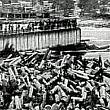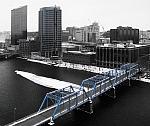
The Grand River: Friend and Foe
by GRHC
published: February 28th, 2007
As a friend, the Grand River powered flouring mills, saw mills and the machinery of early factories. On July 26th, 1880, Grand Rapids became the first city in the country to use water power to generate electricity for lighting. However, the first settlers learned almost immediately that the river had a treacherous side. The earliest recorded flood was 1832. During February of 1838 ice which had built up in the river began to move. With a great rumbling sound it piled up twenty-to-thirty-feet high and forced the water back over the small village. (Find more information to your right in Related Items)
The log jam of 1883 produced one of the most startling events on the river. Heavy rains in June and July of 1883 had caused the river to rise about twenty inches. Lumbermen took advantage of the high water to bring their logs down river where they were held by booms located above the rapids. The logs broke loose, came down river.
Logs piled up against the Detroit, Grand Haven & Milwaukee Railroad bridge creating a jam estimated at thirty-feet deep and seven-miles long. The event drew thousands of people to the river, and some daring souls ventured onto the logs. Photographers took full advantage of the opportunity and left us an excellent visual record.
The Daily Democrat reported on July 26th that the D.G.H. & M. Railroad bridge had been "braced, anchored, and strengthened against the logs." In the morning, "the log jam was still there. So was the bridge. So was the water. So were the people." However, the logs broke through and three spans of the railroad bridge gave way leaving 300 unbridged feet from the western end. The Grand Rapids and Indiana RR bridge above Fulton St. and the Chicago and West Michigan RR bridge above Wealthy St. were destroyed, but the rest of the city's bridges were only slightly damaged.
The log jam created flooding in the low areas of the city, particularly on the low-lying west side, and the Daily Times of August 1, 1883, reported cases of malaria there as a result of the flood. But the greatest flood took place in March of 1904 after a winter of unusually heavy snowfall. Water reached a height of 20.4 feet at Pearl St. putting almost the entire west side under water. Fifty boats were used to rescue stranded citizens.
After the 1904 flood a combination of flood walls and earthwork embankments were built to keep the river within its bed. "Grand Rapids is about the only river town in the country that has grappled with the overflow problem and is placing itself beyond loss to business and residents by an appropriation of $1,000,000 for flood protection," the GR Press of December 16, 1911, reported. It included four photographs of the projects.
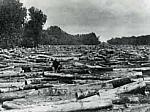
Grand Rapids Historical Commission and the Community Media Center present Glance at the Past, a local history radio project. This week's episode tells of a nearly catastrophic logging incident!
Bibliography
Books available at the GR History and Special Collections, Grand Rapids Public Library
- Baxter, Albert. History of the City of Grand Rapids, Michigan. New York, Grand Rapids: Munsell & company, 1891.
- Chrysler, Don. The Story of Grand River: A Bicentennial History. Grand Rapids: Grace Publications, 1975.
- Goss, Dwight. History of Grand Rapids and its Industries. Chicago: C. F. Cooper, 1906.
- Kuiper, Ronald E. Crisis on the Grand: The Log Jam of 1883. Spring Lake: River Road Pub., 1983.
- Lydens, Z.Z. The Story of Grand Rapids. Grand Rapids: Kregel Publications, 1966.

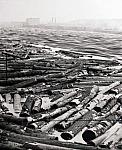
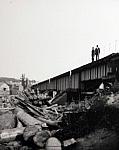
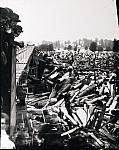
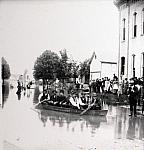
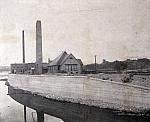
 facebook
facebook
